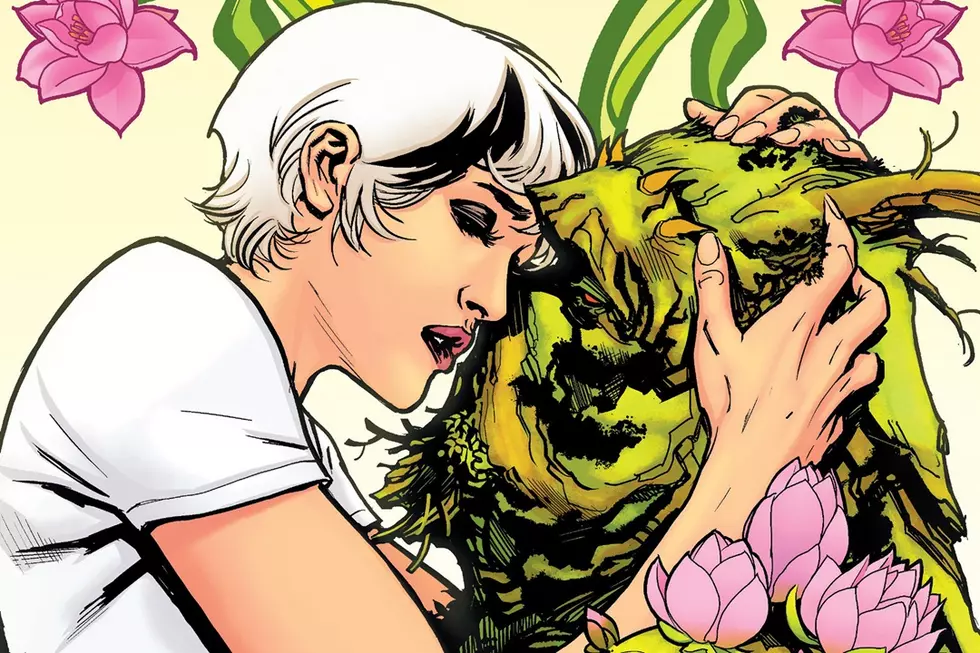
A Ghost Dressed In Weeds: A Celebration Of Swamp Thing
On this day in 1971, DC Comics published House of Secrets #92 which featured, among such stories as “After I Die and “Trick or Treat”, the debut of the soon-to-be iconic character Swamp Thing. Created by Len Wein and Bernie Wrightson, Swamp Thing is one of DC’s most recognizable horror characters, and over the years he has been used as a vessel to tell some of comics most unique stories.
The original Swamp Thing in House of Secrets was a man named Alex Olsen who became Swamp Thing when he was caught in a lab explosion set by a jealous colleague. He kills his would-be murderer, but can no longer face his wife, who believes the swamp monster killed her husband, and so he retreats into the bayou.
When Swamp Thing was spun off into his own series he was now Alex Holland, a scientist who had crafted a bio-restorative formula that could bring life to the most barren desert. He’s assassinated for the formula, but the depths of the swamp and the formula itself turn him into the monstrous Swamp Thing.
Swamp Thing’s iconic look was designed by Wrightson, who also drew the first ten issues of the first volume, which are among the artist’s best work. His Swamp Thing captures the humanity within the monster, yet remain terrifying enough to haunt your dreams.
There was some controversy around the creation of Swamp Thing, as he bore more than a passing resemblance to Marvel’s Man-Thing, and Len Wein had not only written a Man-Thing story, but he was roommates at the time with that character’s creator, Gerry Conway. Marvel never took the matter to court, and both characters grew and evolved in very different ways very quickly.
It was Alan Moore who would take over Swamp Thing and defined the character, capitalizing on the inherent potential of the concept. In a story that was revolutionary at the time, Moore revealed that Swamp Thing was not, in fact, Alec Holland, and never was. Holland died in the swamp, and the entity known as Swamp Thing absorbed his memory and personality. Moore also introduced the idea that Holland was not the first Swamp Thing, tying in the initial Alex Olsen story to the larger mythos.
Moore’s run on The Saga of Swamp Thing introduced the idea of elemental forces to the DC Universe, of which Swamp Thing was the “Earth Elemental” and also introduced John Constantine, who would quickly be spun-off into his own ongoing series, Hellblazer. While originally considered part of DC continuity, Swamp Thing was moved to Vertigo and distanced from the superhero side of DC Comics for over twenty years.
During his run with the character, Alan Moore defined the concept of The Green, which connects all plant-life on Earth. He also wrote the controversial issue where Swamp Thing takes Abigail Arcane on a psychedelic journey into his world, which is meant to represent the two of them becoming physically intimate, despite the limitations afforded by Swamp Thing’s form.
Following Moore’s departure, the series ran for over a hundred more issues, featuring the work of people like Rick Veitch, horror writer Nancy A. Collins, and Mark Millar writing alongside Grant Morrison. There were a couple of attempts through the '90s and beyond to revive the title, but Swamp Thing’s identity fluctuated between Alec Holland and “swamp-based elemental” at the whim of whoever was writing him, and nothing took hold long enough for another defining run.
At the conclusion of DC’s Brightest Day event, Geoff Johns reintroduced Swamp Thing to the DC Universe and resurrected Alec Holland, but it wouldn’t be until The New 52 that Swamp Thing received a new ongoing series, under Scott Snyder and Yanick Paquette. The new volume had Holland compelled by The Green to become the Swamp Thing once more, and was tied in heavily with Jeff Lemire and Travel Foreman’s Animal Man, who were telling similar stories involving the concept of The Red, which connects all animal life. Len Wein then returned to Swamp Thing after more than forty years away for a miniseries with Kelley Jones, which featured a host of cameos from DC’s magical roster, from Zatanna to The Spectre.
From macabre horror to magical fantasy, Swamp Thing has always provided an outlet for creative voices to experiment with wild ideas. The character will likely continue as a vessel for extraordinary creativity for decades to come.
More From ComicsAlliance








![DC Unveils Covers And Solicitations For June’s Bat-Books [Exclusive]](http://townsquare.media/site/622/files/2017/03/Batbooks.png?w=980&q=75)
